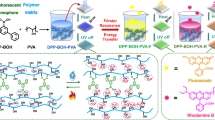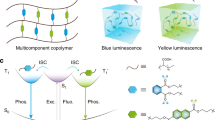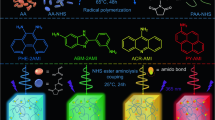Abstract
Polymer-based room temperature phosphorescent (RTP) materials have garnered considerable interest due to their promising applications, such as sensing, fingerprint imaging, information encryption and anti-counterfeiting. Here, we demonstrate a kind of stimulus-responsive RTP materials through facile doping of 4,4′-biphenyldicarboxylic acid (BPA) into poly(vinylalcohol) (PVA) polymer matrix. The resulting polymer film exhibits intriguing sensitivity to both water and heat stimuli, attributed to the disruption of hydrogen bonding interactions within the PVA matrix induced by water. Specifically, a mixture of weakly alkali-treated BPA and PVA solution yields RTP materials with a remarkable phosphorescent lifetime of up to 3 s at room temperature. Additionally, the incorporation of fluorescent dyes enables tunable phosphorescent afterglow colors in the RTP material. By demonstrating its responsiveness to environmental stimuli and exceptional phosphorescent properties, this study advances the understanding and application of polymer-based RTP materials and suggests it as a promising candidate for anti-counterfeiting, fingerprint imaging and information encryption applications.





Similar content being viewed by others
Data and code availability
The data will be made available on request.
References
Guo J, Yang C, Zhao Y (2022) Long-lived organic room-temperature phosphorescence from amorphous polymer systems. Acc Chem Res 55:1160–1170. https://doi.org/10.1021/acs.accounts.2c00038
Kong L, Zhu Y, Sun S et al (2023) Tunable ultralong multicolor and near-infrared emission from polyacrylic acid-based room temperature phosphorescence materials by FRET. Chem Eng J 469:143931. https://doi.org/10.1016/j.cej.2023.143931
Li D, Yang Y, Yang J, Fang M, Tang BZ, Li Z (2022) Completely aqueous processable stimulus responsive organic room temperature phosphorescence materials with tunable afterglow color. Nat Commun 13:347. https://doi.org/10.1038/s41467-022-28011-6
Su Y, Zhang Y, Wang Z et al (2020) Excitation-dependent long-life luminescent polymeric systems under ambient conditions. Angew Chem Int Edit 59:9967–9971. https://doi.org/10.1002/anie.201912102
Gao H, Ma X (2021) Recent progress on pure organic room temperature phosphorescent polymers. Aggregate 2:e38. https://doi.org/10.1002/agt2.38
Abdukayum A, Chen JT, Zhao Q, Yan XP (2013) Functional near infrared-emitting Cr3+/Pr3+ co-doped zinc gallogermanate persistent luminescent nanoparticles with superlong afterglow for in vivo targeted bioimaging. J Am Chem Soc 135:14125–14133. https://doi.org/10.1021/ja404243v
Lai L, Fang B, Fan M, Cheng W, Yin M (2021) Modulating room-temperature phosphorescence through the synergistic effect of heavy-atom effect and halogen bonding. J Phys Chem C 125:16350–16357. https://doi.org/10.1021/acs.jpcc.1c04989
Yang X, Waterhouse GIN, Lu S, Yu J (2023) Recent advances in the design of afterglow materials: mechanisms, structural regulation strategies and applications. Chem Soc Rev 52:8005–8058. https://doi.org/10.1039/d2cs00993e
Chen L, Chen WC, Yang Z et al (2021) Triplet harvesting aryl carbonyl-based luminescent materials: progress and prospective. J Mater Chem C 9:17233–17264. https://doi.org/10.1039/d1tc04184c
Ren C, Wang Z, Wang T et al (2022) Ultralong organic phosphorescence modulation of aromatic carbonyls and multi-component systems. Chinese J Chem 40:1987–2000. https://doi.org/10.1002/cjoc.202200160
Wu H, Gu L, Baryshnikov GV et al (2020) Molecular phosphorescence in polymer matrix with reversible sensitivity. ACS Appl Mater Interfaces 12:20765–20774. https://doi.org/10.1021/acsami.0c04859
Wu B, Guo N, Xu X et al (2020) Ultralong and high-efficiency room temperature phosphorescence of organic-phosphors-doped polymer films enhanced by 3D network. Adv Opt Mater 8:2001192. https://doi.org/10.1002/adom.202001192
Wang Y, Yang J, Fang M et al (2021) New phenothiazine derivatives that exhibit photoinduced room-temperature phosphorescence. Adv Funct Mater 31:2101719. https://doi.org/10.1002/adfm.202101719
Yang J, Fang M, Li Z (2020) Stimulus-responsive room temperature phosphorescence in purely organic luminogens. InfoMat 2:791–806. https://doi.org/10.1002/inf2.12107
Cai S, Ma H, Shi H et al (2019) Enabling long-lived organic room temperature phosphorescence in polymers by subunit interlocking. Nat Commun 10:4247. https://doi.org/10.1038/s41467-019-11749-x
Gu F, Ma X (2022) Stimuli-responsive polymers with room-temperature phosphorescence. Chem-Eur J 28:e202104131. https://doi.org/10.1002/chem.202104131
Wang C, Zhang Y, Wang Z et al (2022) Photo-induced dynamic room temperature phosphorescence based on triphenyl phosphonium containing polymers. Adv Funct Mater 32:2111941. https://doi.org/10.1002/adfm.202111941
Kim S, Yoon SJ, Park SY (2012) Highly fluorescent chameleon nanoparticles and polymer films: multicomponent organic systems that combine FRET and photochromic switching. J Am Chem Soc 134:12091–12097. https://doi.org/10.1021/ja3027295
Wang X, Ma H, Gu M et al (2019) Multicolor ultralong organic phosphorescence through Alkyl engineering for 4D coding applications. Chem Mater 31:5584–5591. https://doi.org/10.1021/acs.chemmater.9b01304
Huang L, Qian C, Ma Z (2020) Stimuli-responsive purely organic room-temperature phosphorescence materials. Chem-Eur J 26:11914–11930. https://doi.org/10.1002/chem.202000526
Wu Q, Zhang KY, Dai P et al (2020) Bioorthogonal “labeling after recognition” affording an fret-based luminescent probe for detecting and imaging Caspase-3 via photoluminescence lifetime imaging. J Am Chem Soc 142:1057–1064. https://doi.org/10.1021/jacs.9b12191
Acknowledgements
This work was supported by the National Natural Science Foundation of China (Grant 21904055), the Natural Science Foundation of Fujian province (Grant 2023J011815 and 2020J05164), and the Office of the President, Minnan Normal University (KJ2023002).
Author information
Authors and Affiliations
Contributions
T.Y. involved in investigation, formal analysis, methodology, validation, and writing—original draft. T.L. contributed to formal analysis, methodology, and data curation. Y.H. involved in formal analysis and methodology. Y.W. involved in formal analysis and data curation. M.C. involved in validation and formal analysis. Y.N. involved in validation and writing—review and editing. Z.C. contributed to funding acquisition, supervision, conceptualization, and writing—review and editing.
Corresponding author
Ethics declarations
Conflict of interest
The authors declare that they have no known competing financial interests or personal relationships that could have appeared to influence the work reported in this paper.
Ethical approval
There are no ethical issues involved in this study.
Additional information
Handling Editor: Pedro Camargo.
Publisher's Note
Springer Nature remains neutral with regard to jurisdictional claims in published maps and institutional affiliations.
Rights and permissions
Springer Nature or its licensor (e.g. a society or other partner) holds exclusive rights to this article under a publishing agreement with the author(s) or other rightsholder(s); author self-archiving of the accepted manuscript version of this article is solely governed by the terms of such publishing agreement and applicable law.
About this article
Cite this article
Yang, T., Li, T., He, Y. et al. Stimulus-responsive room temperature phosphorescent materials based on poly(vinylalcohol) with tunable multicolor afterglow. J Mater Sci (2024). https://doi.org/10.1007/s10853-024-09711-4
Received:
Accepted:
Published:
DOI: https://doi.org/10.1007/s10853-024-09711-4




